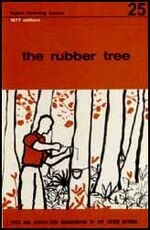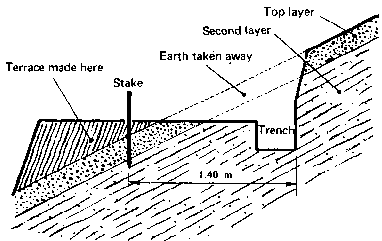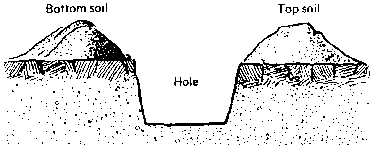To make a good plantation, you must:
- prepare the soil well;
- do the planting well.
Preparing the soil
Choose deep soil that is never flooded. Then the tap- root of the rubber tree can go down well into the soil.
Once the site is chosen, you have to:
- clear the ground;
- stake out the rows;
- make terraces to control erosion.
Remove the trees by grubbing them. Take the earth away round the base of each tree and cut the roots. Then the tree will fall, pulling out its stump.
At the beginning of the dry season, do any burning that is necessary.
- Staking the rows
This means putting stakes where the trees are to be planted. If the ground slopes, the stakes must be placed along the contour lines. Put the stakes 2 metres apart in each row. Make the rows 8 metres apart. This will give 625 plants on 1 hectare.
After this, you must put the grubbed- out trees between the rows.
- Making terraces on the contour lines
When the ground slopes, terraces must be made along the contour lines to prevent erosion.
Take away the soil above the stake and put it lower down.
The terrace should be 2 metres wide.
Dig a trench 0.35 metre deep and 0.35 metre wide.
Make the terrace slope a little against the slope of the land.
The stake is 1.40 metres from the trench.
The terrace
Everything must be finished by the beginning of the rainy season before planting.
At the beginning of the rainy season, sow cover crop plants between the terraces. In forested country use Tithonia diversifolia, in savanna, plant Pueraria.
The site is then ready for the plantation.
Putting the young plants in the plantation[edit | edit source]
At the beginning of the rainy season, put the young plants in the plantation.
A month before planting, make holes at the points marked by the stakes.
The holes should be 60 centimetres deep, 60 centimetres long and 60 centimetres wide. The bottom soil must be kept separate from the top soil.
Refill the hole 10 days before planting, putting the bottom soil down below.
The bottom soil
Take out the young plants in the nursery by cutting the tap- root at a depth of 70 centimetres.
Then trim the plant as follows:
- cut the stem 5 centimetres above the graft;
- cut the tap- root 60 centimetres from the base of the stem;
- trim all side roots back to the tap- root.
Then make a hole with a dibber. Push the tap- root into the soil at the bottom of the hole, and pack the soil well all round the tap- root. The plant must stand upright.
Then fill up the hole, putting back a little soil and pressing it down well. You must put only a little soil at a time and press it well down as you go on.


